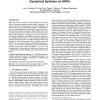2229 search results - page 307 / 446 » Comparative analysis of biclustering algorithms |
KDD
2008
ACM
14 years 10 months ago
2008
ACM
Multi-core processors with ever increasing number of cores per chip are becoming prevalent in modern parallel computing. Our goal is to make use of the multi-core as well as multi...
PODC
2005
ACM
14 years 3 months ago
2005
ACM
We study the distributed complexity of computing a maximal independent set (MIS) in radio networks with completely unknown topology, asynchronous wake-up, and no collision detecti...
EDBT
2006
ACM
14 years 10 months ago
2006
ACM
Abstract. Sensor networks monitor physical phenomena over large geographic regions. Scientists can gain valuable insight into these phenomena, if they understand the underlying dat...
HPDC
2009
IEEE
14 years 5 months ago
2009
IEEE
Advances in the development of large scale distributed computing systems such as Grids and Computing Clouds have intensified the need for developing scheduling algorithms capable...
GECCO
2009
Springer
14 years 4 months ago
2009
Springer
This work provides an analysis of using the evolutionary algorithm EPNet to create ensembles of artificial neural networks to solve a range of forecasting tasks. Several previous...

